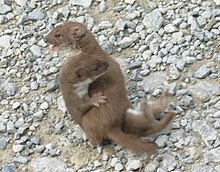Caniformia
Caniformia stands in contrast to the other suborder of Carnivora, the Feliformia ("cat-like" carnivorans), the center of diversification of which was in Africa and southern Asia.
[8] Terrestrial caniforms in the wild are found on all continents with the exception of Antarctica, while pinnipeds are distributed throughout the world's oceans.
Common characteristics of modern bears include a large body with stocky legs, a long snout, shaggy hair, plantigrade paws with five nonretractile claws, and a short tail.
The giant panda is the most herbivorous bear and has evolved a number of adaptations, including a sixth "toe", specialized teeth, and strong jaw muscles, to allow it to feed nearly exclusively on bamboo, a tough member of the grass family.
While not all share identical dentition, they all possess teeth adapted for eating flesh, including the presence of shearing carnassials.
Members of Family Procyonidae (raccoons, coatis) are smallish animals, with generally slender bodies and long tails.
Except for the kinkajou, all procyonids have banded tails and distinct facial markings, and like bears, are plantigrade, walking on the soles of their feet.
[16] The clade is currently divided into three families: Caniforms first appeared as tree-climbing, superficially marten-like carnivores in the Eocene around 42 Mya.
M. cognitus was probably a very agile forest dweller that preyed on smaller animals, such as small mammals, reptiles, and birds.
Like a modern otter, Puijila had a long tail, short limbs, and webbed feet instead of flippers.
However, its limbs and shoulders were more robust, and Puijila likely had been a quadrupedal swimmer–retaining a form of aquatic locomotion that give rise to the major swimming types employed by modern pinnipeds.
The cladogram is based on molecular phylogeny of six genes in Flynn (2005),[15] with the musteloids updated following the multigene analysis of Law et al.




